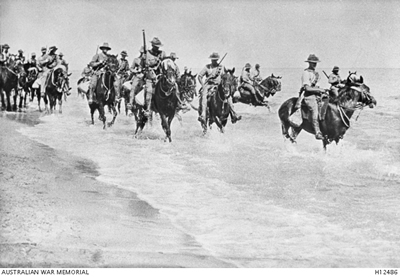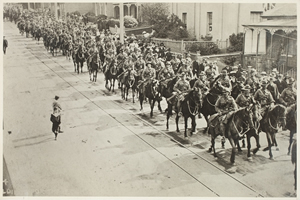English Stage 3
Overview

Australian Army Light horsemen exercising their horses on the edge of the Mediterranean Sea, Middle East, c. 1915
©Public domain (AWM H12486)
Through the text Light Horse Boy by Dianne Wolfer, students explore the use of narrative voice and its effect on the reader. They analyse the images and photos in the text and discuss how they add further meaning. Students compose a letter from the perspective of a soldier or a family member back at home.
Teaching and learning activities

3rd Lighthorse Regiment marching though Hobart, September 1914
©Public domain (Mitchell Library, State Library of NSWhttp://www.acmssearch.sl.nsw.gov.au/search/itemDetailPaged.cgi?itemID=447337)
Light Horse Boy by Dianne Wolfer
In 1914 Jim and Charlie leave the Australian outback to join the adventure of war. However, in the Light Horse they quickly discover the brutal realities of life on the frontline. Readers get an insight into the experience of war through the personal accounts in letters from Jim to his sister.
Discuss the different perspectives in the text: of soldiers, families, generals. Explore the narrative voice throughout the text. What effect does this have on the reader?
Analyse how Australians are represented in the text. Explore the relationships between the soldiers and how mateship is represented, with soldiers and their horses.
Analyse the images and photos in the text and discuss how they add further meaning to the reader.
Encourage students to make connections with characters from the text. Explore how the author has used animals to help readers relate to the characters.
View the images of horses and their role in the First World War from the Experiences tab.
Discuss the effect that historical fiction has on the reader.
Compose a letter from the perspective of a soldier or a family member back at home.
Other texts
Photographs in the Mud by Dianne Wolfer and Brian Harrison-Lever
Soldier Boy: The True Story of Jim Martin the Youngest Anzac by Anthony Hill
It’s a Long way to Tipperary by Jack Judge (song)
For the Fallen by Laurence Binyon (poem)
Learning concepts
These additional questions can be used for discussion or further investigations.
Challenge
Discuss how the author addressed the challenges that different groups of people experienced during the war. What was the challenge experienced with the Light Horse Brigade? How were their challenges different to others?
Change
Discuss how the boy’s perceptions of war quickly changed. What changes occurred throughout the war? How was life different for those who returned? How did the author depict this aspect in the text?
Caring
How did the text explore the different types of care required during the war for the horses and soldiers? Why do you think the author chose to address this in historical fiction?
Commemoration
Explore the poem For the Fallen and discuss how this commemorates the fallen soldiers. What impact does this poem have on the audience?
Syllabus links
EN3-7C thinks imaginatively, creatively, interpretively and critically about information and ideas and identifies connections between texts when responding to and composing texts
Develop and apply contextual knowledge
-
compare how composers and illustrators make stories exciting, moving and absorbing to hold readers' interest
EN3-8D identifies and considers how different viewpoints of their world, including aspects of culture, are represented in texts
Develop and apply contextual knowledge
-
make connections between students' own experiences and those of characters and events represented in texts drawn from different historical, social and cultural contexts(ACELT1613)
-
identify aspects of literary texts that convey details or information about particular social, cultural and historical contexts (ACELT1608)
Respond to and compose texts
-
compose a variety of texts, eg poetry, that reflect their understanding of the world around them